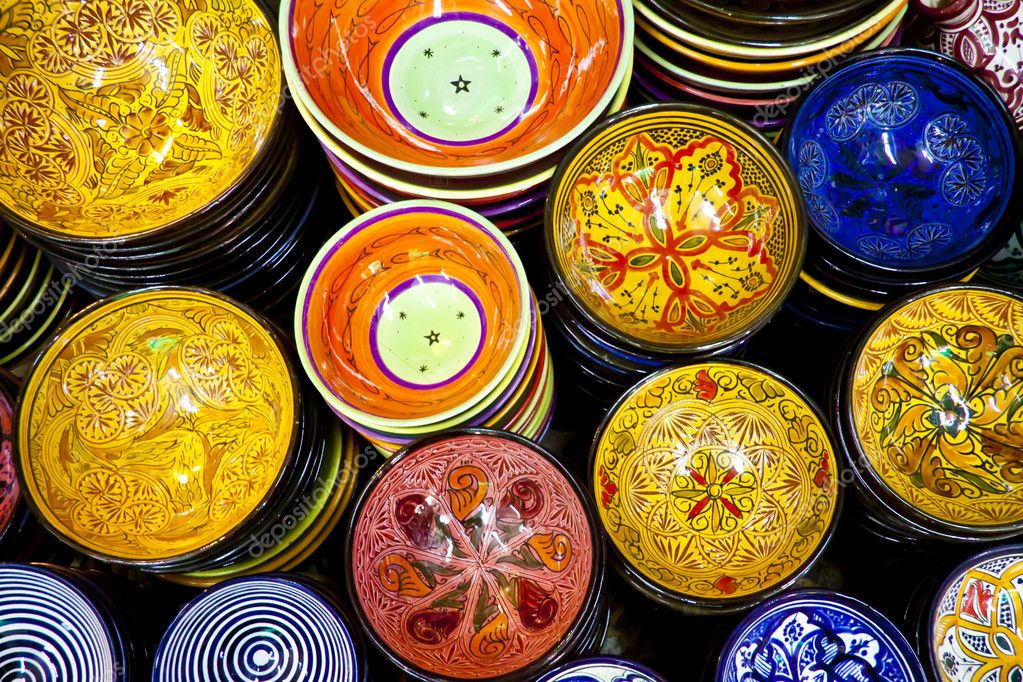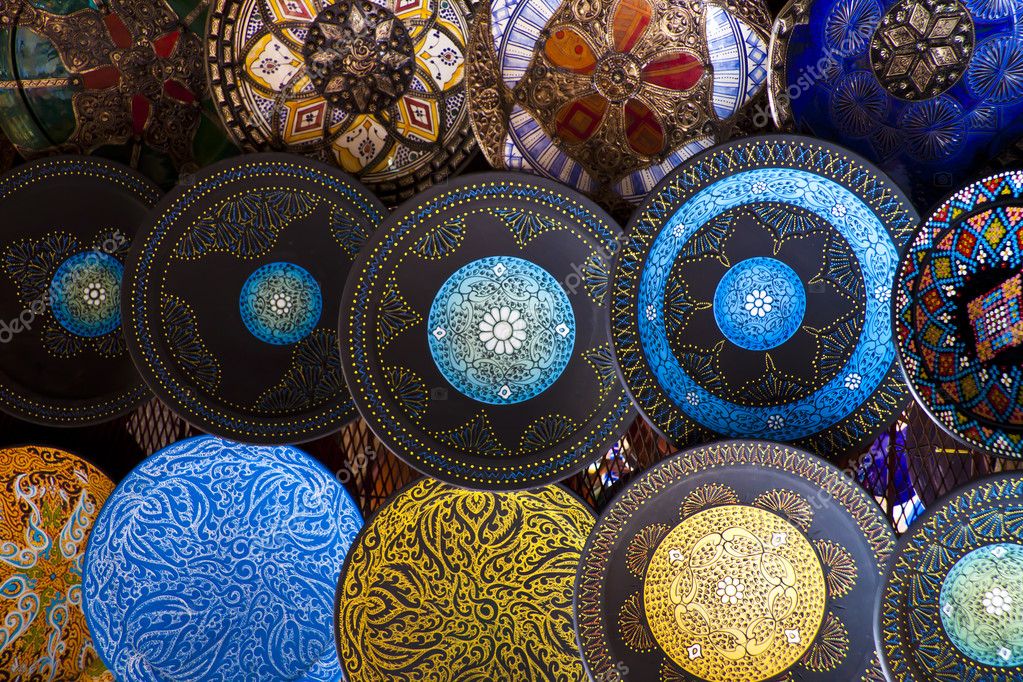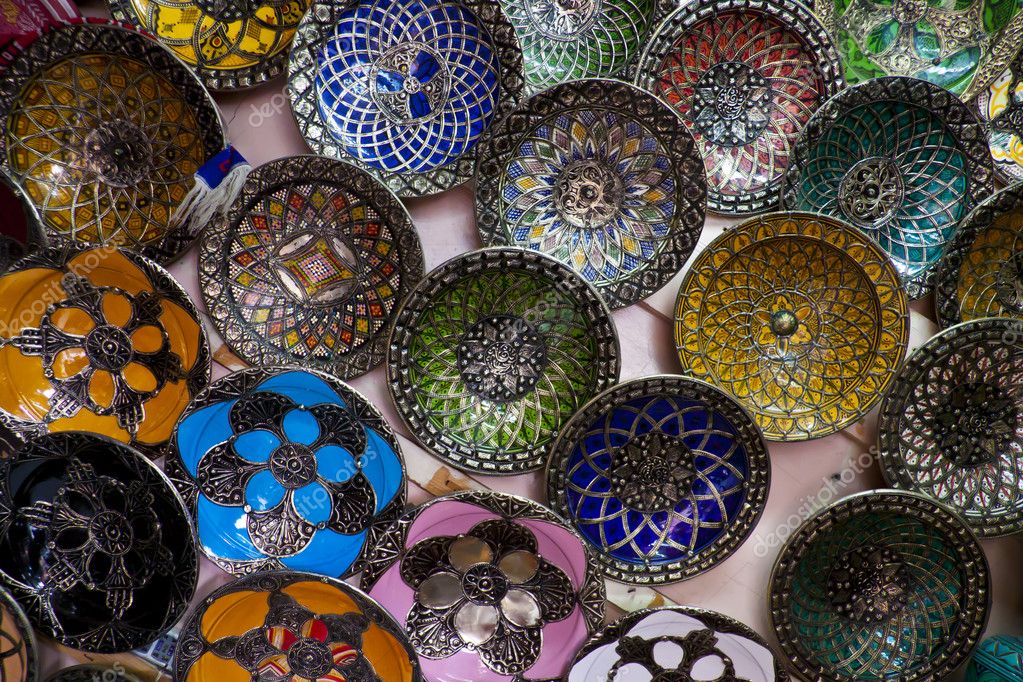Traditional Food in Morocco

Moroccan cooking is strongly characterized by the subtle blending of spices, and Moroccans expertly use them to enhance, rather than mask, the flavor and fragrance of their dishes. Spices such as cayenne, saffron, chilies, cinnamon, turmeric, ginger, cumin, paprika, and black pepper are all commonplace in Morocco, as is a special blend of spices called ras el hanout, translated as "head of the shop," which is usually a mixture of between 10 and 30 different spices. Traditionally the proprietor of each spice shop sold his own unique -- and secret -- ras el hanout recipe. Fresh herbs are also present in Moroccan dishes, particularly garlic, coriander, parsley, and mint, as are fragrant additions such as orange or rose water, olives, and olive oil. Harissa, a fiery paste of garlic, chilies, olive oil, and salt, is often used as a condiment. Above all else, perhaps the defining characteristic of Moroccan cuisine is the blending of savory with sweet, most commonly witnessed by the addition of fruit to meat tagines.
Moroccan food is mostly homegrown, producing a wide range of fruit, vegetables, nuts, and grains, along with large quantities of sheep, cattle, poultry, and seafood. This range of seasonal and mostly organic produce is largely grown and cultivated by small-scale farmers and delivered daily to markets and souks around the country.
Eating in Morocco is a social ritual, and sharing meals at home is fundamental to most Moroccans' way of life. Families take great pride in all aspects of a meal, from purchasing the freshest produce to the preparation, cooking, and display of each dish. Such is the importance of mealtime that many urban families even employ a live-in cook -- sometimes a poorer family relative -- to boost their social standing. Most of the country's maisons d'hôte also employ full-time chefs to entice both residents and nonresidents to their doors. This has resulted in an impressively high number of quality eateries located throughout the country, as well as a new wave of international-Moroccan fusion cuisine.
Food
To get you started, here's a list of common Moroccan food items you'll certainly come across during your travels:
amlou: sweet spread made from almond paste, honey, and argan oil
baghrir: spongelike pancake with little open-air pockets on the top, similar to a large crumpet
brochette: skewered meat grilled over a charcoal fire
couscous: hand-rolled semolina grain steamed until plump and fluffy
harira: soup usually made from vegetable or chicken stock with added chickpea and tomato
kefta: minced lamb or beef generously spiced and either rolled into the shape of a sausage brochette or shaped into meatballs and cooked in a tagine
khalli: poached egg, sometimes cooked and served in a tagine
khübz: circular, flat loaf of bread
mechoui: whole roasted lamb or beef
msemmen: thin, oily, flat bread
pastilla: flaky, phyllo pastry pie with a savory filling of chicken, pigeon, or sometimes seafood, topped with cinnamon or sugar icing
tagine: meat, seafood, and/or vegetable casserole or stew, slowly cooked in a two-piece earthenware cooking vessel with cone-shaped lid
tanjia: earthenware urn stuffed with seasoned meat and slowly cooked in the embers of the local hammam
zaalouk: spiced eggplant dip
Breakfast & Breads -- Morocco's culinary delights begin in the morning. Even the most basic of cafes will usually have an offering of fresh pastries or breads to accompany your coffee, tea, or a freshly squeezed orange juice. Baguettes, croissants, and pain au chocolat are the mainstays of most breakfasts, but you may also encounter Moroccan breads -- best eaten fresh -- such as khübz, msemmen, and baghrir. A personal favorite is a warm baghrir smothered in amlou. If you're staying in one of the country's maisons d'hôte, your breakfast will likely also include a selection of jams, or confitures, yogurt, and fresh fruit, as well as boiled eggs and omelets.
Sandwiches & Snacks -- Snak restaurants can be found all over Morocco, ranging from hole-in-the-wall pavement specials to larger, sit-down establishments. Dishes on offer will range from sandwiches, pizza, and frites (french fries) to chawarma (roasted meat in pita bread) and more substantial dishes such as brochettes. The Moroccan version of a sandwich comes in either a baguette or khübz, and usually involves choosing from a displayed selection of meats, salads, and sauces; ask for plats emporter if you want it as a takeaway. Boiled snails -- not the large French variety but small brown-and-cream banded snails known as babouche -- are commonly sold from street food stalls, and a bowl of snail soup is considered a great restorative. Harira is another soup, and can be eaten on its own or as part of a larger meal. During Ramadan, harira is often drunk at dusk to break the fast. There are many recipes for harira, with the basic stock including chickpea and tomato, bean, and pasta; or chicken and pepper. I recommend a squeeze of lemon to add a little sharpness to the taste.
Salads -- The abundance of fresh fruit and vegetables throughout Morocco -- even out to the edge of the Saharan dunes -- lends itself to a delicious variety of salads. Almost everywhere you will be offered a salade Marocain (finely chopped tomatoes, cucumber, and sometimes green pepper), or at the very least a salade vert of lettuce and tomatoes. Vegetarians will prefer the salad course offered by many fine restaurants called meze. This mélange of small dishes can include spiced eggplant dip called zaalouk, herbed baby potatoes, honeyed carrots, puréed pumpkin with cinnamon, and roasted tomato relish.
Seafood -- Morocco's Atlantic coastline, including the disputed Western Sahara, is a much sought-after fishing ground, and for good reason. The cold, nutrient-rich waters have always provided the country's markets and restaurants with a wide range of fresh seafood year-round. Lately, however, there has been a decline in the daily catch, widely attributed to overfishing. Still, on any given day along the coast, and in the major inland cities thanks to refrigerated transport, you're still likely to be spoiled for choice, with fresh catches of Saint-Pierre (John Dory), dorade (sea bream), merlan (whiting), and sardines. Oualidia's oyster farms ensure a steady domestic supply of the popular mollusk, while crevettes (prawns/shrimps) and homard (lobster) are also regularly featured in menus.
Meat -- Moroccans love their meat, and the concept of vegetarianism causes some looks of confusion among locals, who presume that seafood will still be eaten; hence a vegetarian salad usually comes with tuna. Lamb is favored and enjoyed with couscous, in tagines, skewered over charcoal, braised, boiled, or slow roasted until delectably tender for mechoui. Beef and chicken are more affordable and are also served in a variety of ways, including flame-grilled rotisserie chicken, a popular snak meal.
Couscous -- Originating in either Algeria or Morocco in the 13th century, couscous -- Morocco's national dish -- is a fine semolina grain that is traditionally hand-rolled before being steamed over a simmering stew. Ready when plump and fluffy, the grains are then piled into a large platter or tagine dish, with the stew then heaped on top. It's traditionally served after a tagine or mechoui, and is the crowning dish from which most Moroccans will judge a meal. If you're invited to a Moroccan's home for the traditional Friday midday couscous, be aware that every Moroccan man's wife or mother cooks the best couscous in Morocco, and to state otherwise is comparable to treason.
Pastilla -- Sometimes called bisteeya, this is a sweet and savory pastry consisting of shredded chicken or pigeon mixed with egg and crushed almonds. The mixture is enclosed in a phyllolike pastry called warka, which is topped with cinnamon and sugar icing. Pastilla is considered a delicacy, so some restaurants may not always have it available.
Tagine -- Tagine is a casserole or stew traditionally cooked over a smoldering charcoal fire in a two-piece, cone-shape, earthenware vessel, which is also called a tagine and from where the dish gets its name. Tagines come in many delectable combinations such as beef with prunes, chicken with preserved lemon, and lamb with dates, but can also consist of kefta topped with egg, seafood, or purely vegetables.
Tanjia -- Like tagine, tanjia owes its name to the earthenware vessel in which it is cooked. A classic Marrakchi dish, large cuts of seasoned, spiced beef or lamb are stuffed into the tanjia, which is then tied with paper and string and taken to the local hammam. The hammam's farnatchi -- the man responsible for stoking the furnace -- buries the tanjia vessel in the embers and leaves it to slowly cook for a few hours, after which the meat is tender and ready to eat. This is traditionally a dish made by men for men and is prepared for a bachelor party or all-male gathering.
Desserts & Sweets -- Besides mint tea , dessert will usually consist of sweet Moroccan pastries dripping in honey or dusted in cinnamon and sugar icing. Some top restaurants offer pastilla au lait -- layers of crispy, flaky pastry smothered in sweetened milk and amlou and topped with crushed nuts. Sfenj is a deep-fried Moroccan doughnut, and can be seen threaded six at a time on a piece of bamboo reed or palm frond. Patisseries are everywhere in Morocco -- a legacy left behind by the French -- and the quality of pastries and gâteaux (cakes) is excellent. For something truly Moroccan, try the gazelle horns, which are small, crescent-shaped pastries stuffed with marzipan.
Drink
Beverages -- Night and day, Moroccans are rehydrated by two popular drinks -- freshly squeezed orange juice and mint tea, the national drink. Both can be found in cafes and snak restaurants countrywide, and are an excellent pick-me-up for the overheated traveler.
Moroccan males are especially keen on their coffee, another legacy of the French occupation. No self-respecting Moroccan cafe would dare serve instant coffee, and coffee lovers can find fresh cappuccino, espresso, or coffee with milk just about anywhere at any time.
Water -- Many Western travelers -- especially those from colder climes -- suffer from dehydration during their Moroccan travels. This needn't happen, as cheap bottled water is available everywhere. The best still-water brands are Sidi Ali and Ciel, while Oulmes is the most commonly available sparkling water. Most tap water in Morocco is also drinkable, but it's safer to stick to bottled water.
Beer, Wine & Liquor -- Morocco is by no means a dry country, but drinking in public is still frowned upon and is extremely ignorant if practiced near a mosque. Besides a few select establishments -- mainly in Marrakech -- Moroccan bars, called brasseries, are all-male, smoky drinking dens that are only for the desperately thirsty and are unpleasant for females. Most upscale restaurants, however, will have a liquor license, and should be able to offer beer, if not also wine and spirits. Many tourist hotels will also have an attached bar, although some of them are also the domain of chain-smoking businessmen and prostitutes.
Morocco has three local brands of beer -- Casablanca, Stork, and Flag -- of which the latter is my personal recommendation, while Heineken is the most readily available imported beer. There are also a few surprisingly palatable Moroccan wines available, including an elegant Gris de Guerrouane rosé along with many French brands.
The supermarket chains Acima and Marjane are found in various cities throughout Morocco, have well-stocked liquor stores, and have even been known to stay open for non-Muslims during Ramadan. Other liquor stores can be hard to locate, but you can ask at your hotel. Within most of the country's medinas, the only alcohol to be found will be in select tourist hotels and restaurants.
The cuisine in Morocco is as varied as the country’s landscape, in part due to numerous culinary influences such as Spain, France, Portugal, Italy, Senegal, Turkey and the Berbers. Morocco imports very little food, so its Mediterranean spread of fruits and vegetables tend to be locally grown and fresh. Much of the country’s livestock is free range—picture cattle meandering in the mountains and valleys—resulting in fresh, flavorful meat.
Although each region is known for its unique flavors and dishes, meals throughout the country commonly feature meats with veggies and are often spiced with cumin, cinnamon, saffron and paprika. This bouquet of flavors is woven into Morocco’s breakfasts, lunches, and dinners.
Breakfast
Whether you prefer your breakfast big or small, packed with carbs or protein, the variety of Morocco’s traditional breakfast options should leave you feeling satisfied and ready for a full day of exploring.
To start the day with a light meal, stop by a street stall for Moroccan pita bread. Freshly squeezed orange juice is also abundant on the street, but you may want to bring your own cup, since many vendors only quickly rinse their glasses between customers. Other likely finds include seasonal fruit, French pastries (which can come with honey or jam), doughnuts and, of course, coffee and mint tea.
If your body demands something more substantial before venturing out, a sit down meal will likely offer all of the options from the streets plus omelets with a touch of fresh cumin, Moroccan pancakes and perhaps even lamb’s head.
Lunch
Lunch is traditionally the biggest meal of the day (except during Ramadan), typically taking place from noon to 3:00 p.m. or so, followed by a nap. Many places close over the lunch hour (although a lot of venues that cater to tourists stay open), so it may be worthwhile to take your time and opt for a sit down meal. This more formal lunch is generally served over multiple courses, so be prepared to stay for a while.
Salad, accompanied by homemade bread, is the first course in a sit down meal and includes an array of veggies such as tomatoes, onions, green peppers, beets, garlic and eggplant, as well as spices and herbs.
Couscous is a traditional main course. It is often cooked with veggies, nuts and spices and served with meat, such as roasted lamb or chicken cooked with lemon and olives. Morocco is also well known for tagine, a richly flavored stew that is slow-cooked in an earthen pot. There are numerous varieties of tagine, but simply put, this stew typically consists of meats, veggies and sauce, flavored with a combination of Moroccan spices.
Dessert is often served at some point during the meal rather than at the end. With desserts like bastilla (layers of flaky pastry with toasted almonds, cinnamon and cream), gazelle’s horns (a pastry with almond paste, sprinkled with sugar), coconut fudge cakes, almond cookies and orange slices with cinnamon, sampling these goodies while you still have room is absolutely worthwhile. At the end of the meal, you can expect to wind down with a sweetened mint tea.
As with breakfast, your best bet for a quicker, lighter lunch is to pick up something from a street vendor. If you look for a stall with a line of locals, you’re more apt to find a clean place with a reputation for fresh, tasty food.
Kebabs are quite popular in Morocco and easy to grab on the go. They typically include veggies plus chicken, lamb, meatballs (which may be made from beef or lamb) or a mix of meats (which can include kidney, liver and heart). Lamb sausage and pizza are also common finds, and seafood is especially plentiful along the Atlantic coast. If you’re willing to sit down for a moment, consider picking up a stew and pita bread.
Dinner
Starting around 9:00 p.m., dinner is usually a lighter meal eaten at home. Harira is a traditional dinner dish (especially during Ramadan), which is a thick tomato and lentil soup with lamb, chickpeas, noodles, cinnamon, ginger, turmeric and cayenne. Street stalls offer more snack-like evening options like roasted almonds, cumin-spiced hard-boiled eggs and roasted corn. Bocaillos (sandwiches) have become increasingly popular in Morocco. They’re usually made with your choice of meat, seafood or omelet along with veggies.


